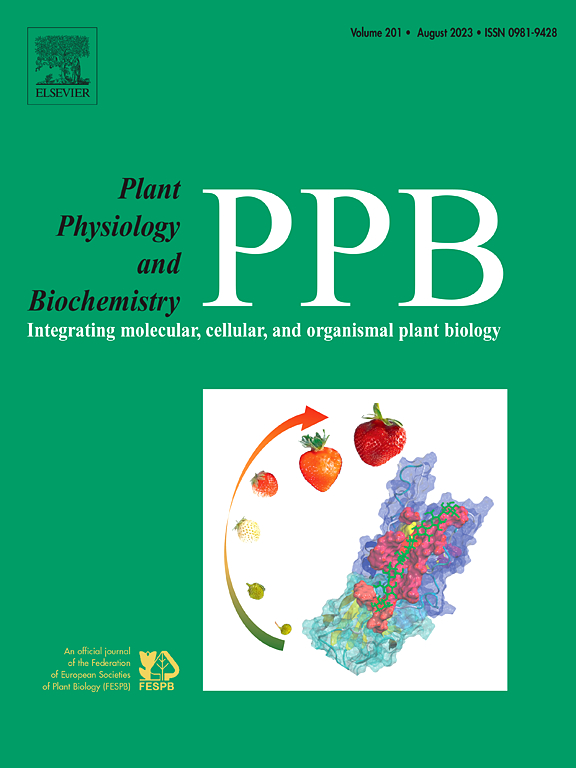The L-type lectin receptor-like kinase GmLecRK-IX negatively regulates drought stress responses in soybean seedlings
IF 6.1
2区 生物学
Q1 PLANT SCIENCES
引用次数: 0
Abstract
Soybean (Glycine max (L.) Merr.), a prominent oilseed crop grown around the world, provides essential resources for the human diet as well as livestock feed. However, drought stress severely impacts soybean yield and quality. The presence of lectin receptor-like kinases (LecRLKs) has been identified as being pivotal to plant development and the manifestation of responses to environmental stresses. Nevertheless, there is a paucity of literature on the involvement of LecRLKs in the response of soybean to drought conditions. In this investigation, we discovered an L-type soybean LecRK-IX gene (Glyma.09G150400) using transcriptomic and proteomic approaches. Quantitative reverse transcription PCR analysis revealed that drought stress significantly elevated GmLecRK-IX gene expression. Subcellular localization results indicated that GmLecRK-IX was localized to the endoplasmic reticulum (ER) and the plasma membrane of Nicotiana benthamiana leaves and Arabidopsis protoplasts. Expression pattern analysis revealed that GmLecRK-IX was predominantly expressed in the roots and seeds. Transgenic Arabidopsis plants overexpressing the GmLecRK-IX gene displayed heightened sensitivity to drought, as evidenced by a decreased survival rate, reduced proline content, and elevated malondialdehyde (MDA) levels following drought stress treatment. Furthermore, the transgenic GmLecRK-IX overexpressed (-OE) lines of soybean exhibited a negative effect on the capacity to withstand drought conditions. The transgenic soybean GmLecRK-IX-OE lines exhibited lower levels of leaf water and proline, a higher rate of water loss, increased MDA content, and reduced activities of antioxidant enzymes. RNA-sequencing analysis further revealed that the GmLecRK-IX-OE lines exhibited altered expression of the genes encoding peroxidase (PRXs) and plasma membrane intrinsic proteins (PIPs) in soybean under drought conditions. Our research has uncovered a novel regulatory mechanism in soybean under drought stress and identified potential target genes for development drought-tolerant soybean varieties.
l型凝集素受体样激酶GmLecRK-IX负调控大豆幼苗干旱胁迫反应
大豆(甘氨酸max (l))小麦(Merr.)是一种在世界各地种植的著名油籽作物,为人类饮食和牲畜饲料提供了重要的资源。然而,干旱胁迫严重影响大豆的产量和品质。凝集素受体样激酶(LecRLKs)的存在已被确定为植物发育和对环境胁迫反应的关键表现。然而,关于LecRLKs参与大豆对干旱条件的反应的文献很少。本研究利用转录组学和蛋白质组学方法,发现了一个l型大豆LecRK-IX基因(Glyma.09G150400)。定量反转录PCR分析显示,干旱胁迫显著提高了GmLecRK-IX基因的表达。亚细胞定位结果表明,GmLecRK-IX定位于烟叶和拟南芥原生质体的内质网和质膜。表达谱分析显示,GmLecRK-IX主要在根和种子中表达。过度表达GmLecRK-IX基因的转基因拟南芥植株对干旱表现出更高的敏感性,在干旱胁迫处理后,其成活率下降,脯氨酸含量降低,丙二醛(MDA)水平升高。此外,转基因GmLecRK-IX过表达株系(-OE)对大豆抗旱能力有负面影响。转基因大豆GmLecRK-IX-OE株系叶片水分和脯氨酸含量降低,水分流失率升高,丙二醛含量升高,抗氧化酶活性降低。rna测序分析进一步发现,干旱条件下GmLecRK-IX-OE大豆过氧化物酶(PRXs)和质膜内在蛋白(PIPs)编码基因表达发生改变。我们的研究揭示了大豆在干旱胁迫下的新的调控机制,并确定了培育耐旱大豆品种的潜在靶基因。
本文章由计算机程序翻译,如有差异,请以英文原文为准。
求助全文
约1分钟内获得全文
求助全文
来源期刊
CiteScore
11.10
自引率
3.10%
发文量
410
审稿时长
33 days
期刊介绍:
Plant Physiology and Biochemistry publishes original theoretical, experimental and technical contributions in the various fields of plant physiology (biochemistry, physiology, structure, genetics, plant-microbe interactions, etc.) at diverse levels of integration (molecular, subcellular, cellular, organ, whole plant, environmental). Opinions expressed in the journal are the sole responsibility of the authors and publication does not imply the editors'' agreement.
Manuscripts describing molecular-genetic and/or gene expression data that are not integrated with biochemical analysis and/or actual measurements of plant physiological processes are not suitable for PPB. Also "Omics" studies (transcriptomics, proteomics, metabolomics, etc.) reporting descriptive analysis without an element of functional validation assays, will not be considered. Similarly, applied agronomic or phytochemical studies that generate no new, fundamental insights in plant physiological and/or biochemical processes are not suitable for publication in PPB.
Plant Physiology and Biochemistry publishes several types of articles: Reviews, Papers and Short Papers. Articles for Reviews are either invited by the editor or proposed by the authors for the editor''s prior agreement. Reviews should not exceed 40 typewritten pages and Short Papers no more than approximately 8 typewritten pages. The fundamental character of Plant Physiology and Biochemistry remains that of a journal for original results.

 求助内容:
求助内容: 应助结果提醒方式:
应助结果提醒方式:


